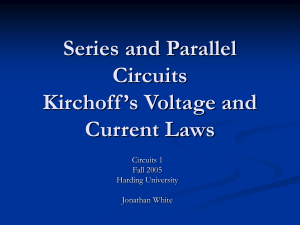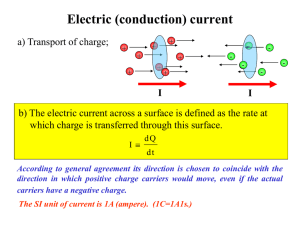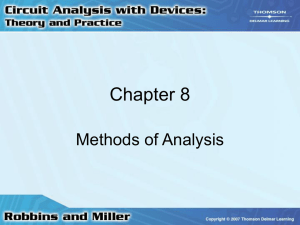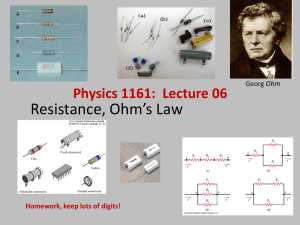Lect19
advertisement
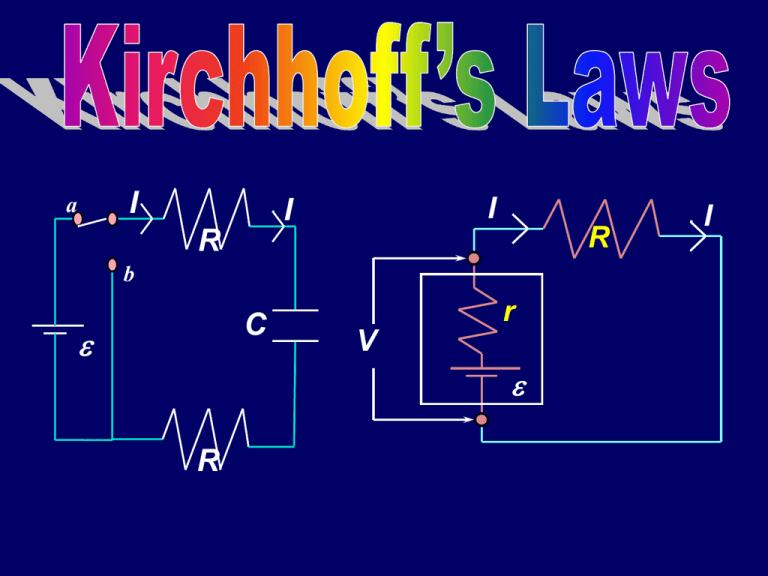
I a I I R R b C e r V e R I Yesterday • Ohm’s Law V=IR • Ohm’s law isn’t a true law but a good approximation for typical electrical circuit materials • Resistivity =1/ (Conductivity): Property of the material • Resistance proportional to resistivity and length, inversely proportional to area L R A Question 1 Two cylindrical resistors are made from the same material, and they are equal in length. The first resistor has diameter d, and the second resistor has diameter 2d. Compare the resistance of the two cylinders. a) R1 > R2 b) R1 = R2 c) R1 < R2 Question 1 1. a 2. b 3. c Question 1 Two cylindrical resistors are made from the same material, and they are equal in length. The first resistor has diameter d, and the second resistor has diameter 2d. Compare the resistance of the two cylinders. a) R1 > R2 b) R1 = R2 c) R1 < R2 • Resistance is proportional to Length/Area Question 2 Two cylindrical resistors are made from the same material, and they are equal in length. The first resistor has diameter d, and the second resistor has diameter 2d. If the same current flows through both resistors, compare the average velocities of the electrons in the two resistors: a) v1 > v2 b) v1 = v2 c) v1 < v2 Question 2 1. a 2. b 3. c Question 2 Two cylindrical resistors are made from the same material, and they are equal in length. The first resistor has diameter d, and the second resistor has diameter 2d. If the same current flows through both resistors, compare the average velocities of the electrons in the two resistors: a) v1 > v2 b) v1 = v2 c) v1 < v2 Current Area Current Density Current Density average velocity of electrons I is the same A1<A2 v1>v2 Resistors in Series •What is the same effective single resistance to two resistances in series? •Whenever devices are in SERIES, the current is the same through both. •By Ohm’s law, the Voltage difference across resistance R1 is V V IR a •Across R2 is b 1 I a R1 b R2 c a Vb Vc IR2 •Total voltage difference Va Vc I ( R1 R2 ) Reffective • the effective single resistance is Reffective ( R1 R2 ) c Another (intuitive) way… R1 •Consider two cylindrical resistors with lengths L1 and L2 L V R1 1 A L2 R2 A L1 L2 R2 •Put them together, end to end to make a longer one... L1 L2 Reffective R1 R2 A R R1 R2 The World’s Simplest (and most useful) circuit: Voltage Divider R1 V ? V V0 V IR2 R2 R1 R2 V0 R2 R2 R1 By varying R2 we can controllably adjust the output voltage! R2 R1 R2 R1 V=0 V0 V= 2 V=V0 Question 3 Two resistors are connected in series to a battery with emf E. The resistances are such that R1 = 2R2. The currents through the resistors are I1 and I2 and the potential differences across the resistors V1 and V2. Are: a) I1>I2 and V2=E b) I1=I2 and V2= E c) I1=I2 and V2=1/3E d) I1<I2 and V2=1/2E e) I1<I2 and V2=1/3E Resistors in Parallel • Very generally, devices in parallel have the same voltage drop • Current through R1 is I1. • Current through R2 is I2. V I1R1 a V V V R R1 R2 R2 I I a V 1 1 1 R R1 R2 I2 R1 d • But current is conserved I1 V V I 2 R2 I I1 I 2 I R d I Another (intuitive) way… Consider two cylindrical resistors with cross-sectional areas A1 and A2 L R1 A1 L R2 A2 V A1 R1 Put them together, side by side … to make one “fatter”one, L A1 A2 1 1 1 Reffective Reffective L L R1 R2 A1 A2 1 1 1 R R1 R2 A2 R2 Kirchhoff’s First Rule “Loop Rule” or “Kirchhoff’s Voltage Law (KVL)” "When any closed circuit loop is traversed, the algebraic sum of the changes in potential must equal zero." KVL: V n 0 loop • This is just a restatement of what you already know: that the potential difference is independent of path! e1 I e 1 R1 IR1 R2 IR2 e2 e 2 0 Rules of the Road Our convention: • Voltage gains enter with a + sign, and voltage drops enter with a sign. • We choose a direction for the current and move around the circuit in that direction. • When a battery is traversed from the negative terminal to the positive terminal, the voltage increases, and hence the battery voltage enters KVL with a + sign. • When moving across a resistor, the voltage drops, and hence enters KVL with a sign. e1 e 1 I R1 R2 IR1 IR2 e2 e 2 0 Current in a Loop R1 e 1 Start at point a (could be anywhere) and assume current is in direction shown (could be either) b V n f a I I d c R2 KVL: R4 e2 e R3 0 IR1 IR2 e 2 IR3 IR4 e1 0 e1 e 2 I R1 R2 R3 R4 loop Question 3 • Consider the circuit shown. – The switch is initially open and the current flowing through the bottom resistor is I0. – Just after the switch is closed, the current flowing through the bottom resistor is I1. – What is the relation between I0 and I1? (a) I1 < I0 (b) I1 = I0 12V R a I 12V 12V R b (c) I1 > I0 Question 3 1. a 2. b 3. c Question 3 • Consider the circuit shown. – The switch is initially open and the current flowing through the bottom resistor is I0. – Just after the switch is closed, the current flowing through the bottom resistor is I1. – What is the relation between I0 and I1? (a) I1 < I0 (b) I1 = I0 12V R a I 12V 12V R b (c) I1 > I0 • From symmetry the potential (Va-Vb) before the switch is closed is Va-Vb = +12V. • Therefore, when the switch is closed, potential stays the same and NO additional current will flow! • Therefore, the current before the switch is closed is equal to the current after the switch is closed. Question 3 • Consider the circuit shown. – The switch is initially open and the current flowing through the bottom resistor is I0. – After the switch is closed, the current 12V flowing through the bottom resistor is I1. – What is the relation between I0 and I1? (a) I1 < I0 • • (b) I1 = I0 Write a loop law for original loop: 12V +12V I0R I0R = 0 I0 = 12V/R Write a loop law for the new loop: 12V I1R = 0 I1 = 12V/R 12V R a I R b (c) I1 > I0 12V Kirchhoff’s Second Rule “Junction Rule” or “Kirchhoff’s Current Law (KCL)” • In deriving the formula for the equivalent resistance of 2 resistors in parallel, we applied Kirchhoff's Second Rule (the junction rule). "At any junction point in a circuit where the current can divide (also called a node), the sum of the currents into the node must equal the sum of the currents out of the node." I in I out • This is just a statement of the conservation of charge at any given node. • The currents entering and leaving circuit nodes are known as “branch currents”. • Each distinct branch must have a current, Ii assigned to it How to use Kirchhoff’s Laws A two loop example: R1 I3 e1 e2 I2 I1 R2 R3 • Assume currents in each section of the circuit, identify all circuit nodes and use KCL. (1) I1 = I2 + I3 • Identify all independent loops and use KVL. 2 e1 I1R1 I2R2 = 0 (3) I2R2 e2 I3R3 = 0 4 e1 I1R1 e2 I3R3 0 How to use Kirchoff’s Laws R1 I3 e2 I2 I1 e1 R2 R3 • Solve the equations for I1, I2, and I3: First find I2 and I3 in terms of I1 : I 2 (e1 I1R1 ) / R2 From eqn. (2) I3 (e1 e 2 I1R1 ) / R3 Now solve for I1 using eqn. (1): I1 e1 R2 e1 e 2 R3 R1 R1 I1 ( ) R2 R3 e1 R2 From eqn. (3) e1 e 2 R3 I1 R R 1 1 1 R2 R3 Let’s plug in some numbers R1 e2 I2 I1 e1 e1 = 24 V I3 R2 e 2 = 12 V Then, R3 R1= 5W R2=3W R3=4W and I1=2.809 A I2= 3.319 A, I3= -0.511 A Junction Demo Junction: e1 I1 I 2 I 3 R Outside loop: e1 I1R I3 R e3 0 I1 I2 e2 R Top loop: e1 I1R e 2 I 2 R 0 2e1 e 2 e 3 I1 3R I2 e1 e 3 2e 2 3R I3 e3 R e1 e 2 2e 3 I3 3R 1 Summary • Kirchhoff’s Laws – KCL: Junction Rule (Charge is conserved) – Review KVL (V is independent of path) • Non-ideal Batteries & Power • Discharging of capacitor through a Resistor: Q (t ) Q0 e t RC Reading Assignment: Chapter 26.6 Examples: 26.17,18 and 19 Two identical light bulbs are represented by the resistors R2 and R3 (R2 = R3 ). The switch S is initially open. 2) If switch S is closed, what happens to the brightness of the bulb R2? a) It increases b) It decreases c) It doesn’t change 3) What happens to the current I, after the switch is closed ? a) Iafter = 1/2 Ibefore b) Iafter = Ibefore c) Iafter = 2 Ibefore I Four identical resistors are connected to a battery as shown in the figure. R2 R1 R4 E R3 5) How does the current through the battery change after the switch is closed ? a) Iafter > Ibefore b) Iafter = Ibefore c) Iafter < Ibefore Before: Rtot = 3R Ibefore = 1/3 E/R After: R23 = 2R R423 = 2/3 R Rtot = 5/3 R Iafter = 3/5 E/R



